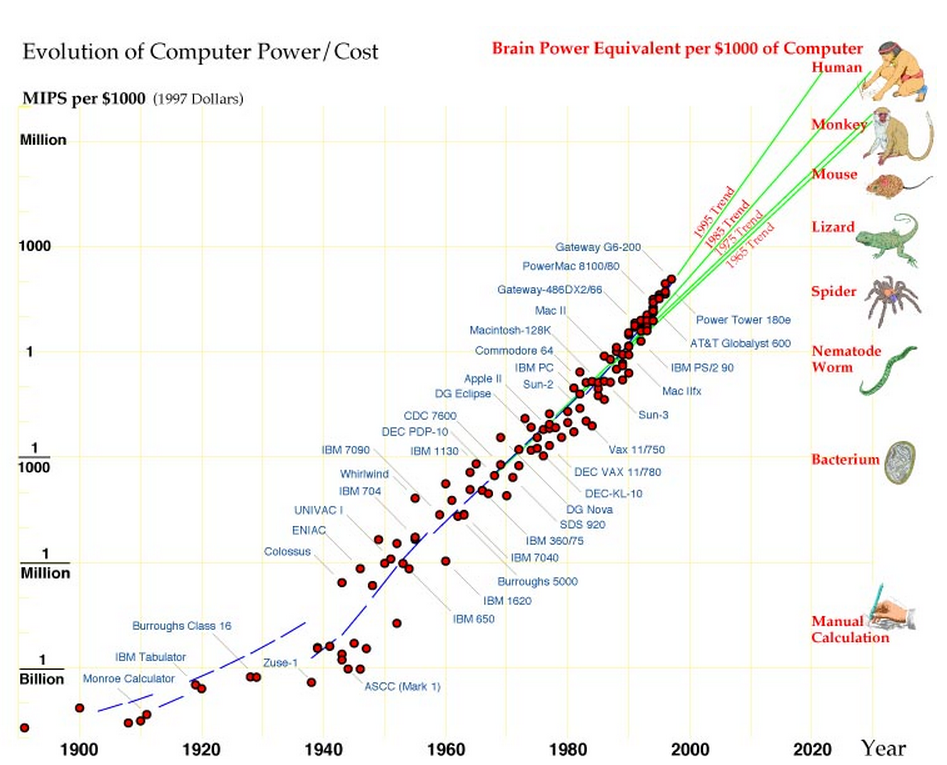By Katja Grace, 4 April 2015
Computer hardware has been getting cheap now for about seventy five years. Relatedly, large computing projects can afford to be increasingly large. If you think the human brain is something like a really impressive computer1, then a natural question is ‘what happens when big projects can afford to use as much computation as the brain?’
One possibility is that we get something like human-level AI then and there. Maybe the brain just uses easy algorithmic ideas, and as soon as someone gets enough hardware together and tries a bit on the brain-like software, the creation will be about as good as a human brain.
Another possibility is that sufficient hardware to simulate a brain is basically irrelevant. On this story, the brain has big algorithmic secrets we don’t know about, and it would take unimaginable warehouses of hardware to replace these insights with brute force computation.
Most possibilities lie somewhere between these two, where hardware and software are both somewhat helpful. In these cases, knowing when we will have enough hardware to run a brain isn’t everything, but is informative. For more discussion of how to model this situation, see our older post.
There doesn’t seem to be consensus on how important hardware is. But given the range of possibilities, whenever ‘human-level hardware’ arrives seems like a disproportionately likely time for human-level AI to arrive.
For this reason, we want to know when this human-level hardware point is. Which means we want to know the price of hardware, how fast that price is falling, how much hardware you need to do what the human brain does, and how much anyone is likely to pay for that. Ideally, we would like a few relatively independent estimates of several of these things.
We’ve just been checking the prices, and price trends, so this seems like a good time to pause and see what they imply when combined with some existing estimates of the brain’s computational requirements. Later we will explore these estimates in more detail, and hopefully add at least one based on measuring TEPS.
Moravec estimates that the brain performs around 100 million MIPS.2 MIPS are not directly comparable to MFLOPS (millions of FLOPS), and have deficiencies as a measure, but the empirical relationship in computers is something like MFLOPS = 2.3 x MIPS0.89, according to Sandberg and Bostrom (2008).3 This suggests Moravec’s estimate coincides with around 3.0 x 10¹³ FLOPS. Given that an order of magnitude increase in computing power per dollar corresponds to about four years of time, knowing that MFLOPS and MIPS are roughly comparable is plenty of precision.
We estimated FLOPShours cost around $10-13 each. Thus if we want to run a brain, putting these figures together, it would cost us around $3/hour!
That is, if Moravec’s estimate was right, and my conversion of it to FLOPS was basically right, and our prices were right, and hardware mattered a lot more than software, we would already be in the robot revolution.4 How informative!
Our prices are pretty consistent with the latest extrapolation in Moravec’s 1997 graph (see Figure 1).5 However his graph doesn’t reach human-equivalence until around 2020, and he predicts such computers appear around then.6 This difference from our reading of his figures is because his graph is of what can be bought with $1,000, whereas we expect someone would build an AI by the time it cost around $1M at the latest.7 So our threshold of ‘affordable’ is three orders of magnitude more expensive than his, and thus a bit over a decade earlier. This seems to be a disagreement about at what price it becomes economically viable to replace a human, but we do not understand his position8 well. A ‘brain’ that costs $1000, and runs for a few years, lets say doing useful work for only 40h/week, is costing $0.16/hour! Yet it can earn at least several hundred times more than that. There are other costs to laboring than having a virtual brain, but not that many.

Incidentally, by 2009, Moravec lengthened his prediction to 20-30 years to ‘close the gap’, seemingly due to cost reductions abating since 1990.9 We don’t know of evidence of this slowing however, and as mentioned, it seems recent hardware prices are in line with his earlier estimates.
Moravec’s is not the only estimate of computation done by the brain. Sandberg and Bostrom (2008) project the processing required to emulate a human brain at different levels of detail.10 For the three levels that their workshop participants considered most plausible, their estimates are 10¹⁸, 10²², and 10²⁵ FLOPS. These would presently cost around $100K/hour, $1bn/hour and $1T/hour.
We estimated that FLOPS are coming down in price by roughly an order of magnitude roughly every four years, so if that is about right and continues, these figures suggest that an AI might compete with a $100/hour human in 12 years, 28 years or 40 years respectively: between 2027 and 2055.
Incidentally, Sandberg and Bostrom predicted a $1M project could purchase enough hardware for a brain between 2019 and 2044 or between 2042 and 2087, depending on whether one is extrapolating retail computing or supercomputing price trends. So our extrapolation of their figures based on recent data is in basically line with theirs. Figure 2 shows roughly where our 2015 FLOPS/$ figures fall on their graph of MFLOPS.

Another estimate of human-level hardware comes from Kurzweil. In The Singularity is Near, he claimed that a human brain required 10¹⁶ calculations per second, which appears to be roughly equivalent to 10¹⁶ FLOPS.11 This would put the current price of human-level hardware at $1000/hour, beginning to be competitive with some highly expensive people, and reaching the $100/hour people in about four years.12
So it seems human-level hardware presently costs between $3/hour and $1T/hour. And the date when we will reach it lies somewhere in a half-century long haze. We have already stepped into the haze: of the five dates we saw, we have passed one, and are reaching another. This is important, because the era of maybe-human-level hardware has a heightened chance of bringing human-level AI.
It is also important to dispel the haze. If we knew there was a substantially heightened chance of human-level AI in the next ten years, we might act differently from how we would if we knew hardware would be lacking for forty years. Also, if were sure we had uneventfully passed human-level hardware, then we could exclude the possibility that hardware was overwhelmingly important, and start on excluding nearby possibilities (e.g. that hardware is pretty important). Knowing better how much difference hardware makes would change our other expectations about the arrival of human-level AI. Though human-level hardware coming sooner would tend to shorten our AI timelines, if we knew that we had already thoroughly passed it we might expect longer timelines.
This has been a preview of our investigation into these things. The next steps will hopefully resolve some ambiguity around how much computation a brain does, or at least add some more to be resolved later.
***
(Featured image: Pyramidal hippocampal neuron 40x by MethoxyRoxy)
- The extent and nature of the brain’s resemblance to a really impressive computer is an important question that we hope to discuss another time. For now, we shall see what this assumption implies, and whether it is worth resolving more nebulous problems for.
- ” it would take, in round numbers, 100 million MIPS (100 trillion instructions per second) to emulate the 1,500-gram human brain.” – Moravec, 2009
- See p89. It actually says FLOPS not MFLOPS, but this appears to be an error, given the graph.
- Humans who cost $100/hour would have become more expensive than the equivalent hardware in about 2009: an hour is currently factor of 30 cheaper than $100, or 1.5 factors of ten, which corresponds to about six years of progress in hardware price performance.
- In 2015, it appears to be at around 2.3 million MIPS/$1000, which is around 1M MFLOPS/$1000 according to Sandberg and Bostrom’s conversion, which is $1 per GFLOP. Our estimate was $3/GFLOP.
- ‘At the present rate, computers suitable for humanlike robots will appear in the 2020s.’ –Moravec
- A computer that lasts for three years and runs a human replacement who can work for around $50/hour should be worth around $1M.
- ‘By our estimate, today’s very biggest supercomputers are within a factor of a hundred of having the power to mimic a human mind. Their successors a decade hence will be more than powerful enough. Yet, it is unlikely that machines costing tens of millions of dollars will be wasted doing what any human can do, when they could instead be solving urgent physical and mathematical problems nothing else can touch. Machines with human-like performance will make economic sense only when they cost less than humans, say when their “brains” cost about $1,000. When will that day arrive?’ – Moravec
- “Since 1990 cost and size reductions have abated, but power has risen to about 10,000 MIPS for a home computer. At the present pace, only about 20 or 30 years will be needed to close the gap…It suggests that robot intelligence will surpass our own well before 2050.”- Moravec, 2009
- From Sandberg and Bostrom, table 9: Processing demands (emulation only, human brain)(p80):
- spiking neural network: 10¹⁸ FLOPS (Earliest year, $1 million: commodity computer estimate: 2042, supercomputer estimate: 2019)
- electrophysiology: 10²² FLOPS (Earliest year, $1 million: commodity computer estimate: 2068, supercomputer estimate: 2033)
- metabolome: 10²⁵ FLOPS (Earliest year, $1 million: commodity computer estimate: 2087, supercomputer estimate: 2044)
- ‘If we use the figure of 10¹⁶ cps that I believe will be sufficient for functional emulation of human intelligence…’ – Kurzweil, The Singularity is Near, p121
- 10¹⁶ x $10-¹³/hour = $1000/hour



I haven’t seen evidence of slowing cost curves since 1990 either, but I did see an Intel presentation about the newest architecture, and that *does* seem to be the first time I saw them acknowledge that the cost per calculation has fallen off a smooth exponential.
Processors per chip has continued as a smooth exponential (but as we know this cannot physically continue more than a couple more jumps). And clock speeds slowed down a long time ago.
I’m quite wary of projecting these Moore’s Law type trends forward for much longer. Those estimates of brain power may become incredibly important…
Hi,
“I haven’t seen evidence of slowing cost curves since 1990 either, but I did see an Intel presentation about the newest architecture, and that *does* seem to be the first time I saw them acknowledge that the cost per calculation has fallen off a smooth exponential.”
I don’t see any fall off from the exponential on the Wikipedia “FLOPS” page:
http://en.wikipedia.org/wiki/FLOPS
hOur site offers a wide variety of non prescription drugs. Look at our health portal in case you want to strengthen your health with a help health products. Our company offers a wide variety of non prescription products. Visit our health portal in case you want to look better with a help health products. Our company provides herbal non prescription products. Take a look at our health contributing website in case you want to feel healthier. Our company provides a wide variety of non prescription drugs. Visit our health site in case you want to strengthen your health with a help generic supplements. Our company offers herbal healthcare products. Look at our health contributing portal in case you want to feel healthier. Our company offers supreme quality health and related products. Visit our health contributing website in case you want to strengthen your health.
Our company offers a wide variety of general health products. Take a look at our health contributing portal in case you want to strengthen your health. Our company offers supreme quality supplements. Look at our health contributing portal in case you want to look better. Our company provides a wide variety of health and related products. Visit our health contributing site in case you want to look healthier. Our company offers a wide variety of non prescription drugs. Take a look at our health site in case you want to look healthier. Our company provides herbal supplements. Visit our health contributing website in case you want to feel better.
Lakshmi Flow
Hello, please contact me. Thanks #aiimpacts.org# or http://www.ask.me